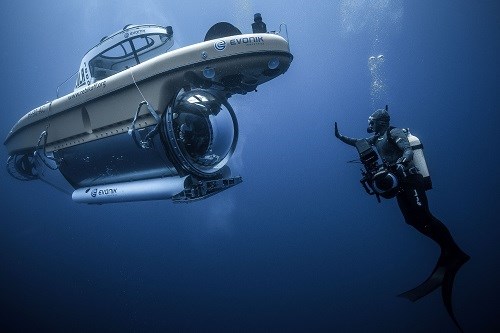Evonik Extends Support Of Deep Sea Exploration
With its Plexiglas observation dome, the Lula1000 submarine is discovering numerous previously unknown species.

I don’t mean this in a flippant way, but here is a nifty ‘non-polluting’ example of plastic in our oceans that is enabling the scientific exploration of our deepest seas
A Plexiglas acrylic observation dome developed by Evonik Industries AG has been playing a key role in manned exploratory journeys to the depths of the ocean. In fact, the company recently announced that it will prolong its support of the non-profit Rebikoff-Niggeler Foundation for an additional two years; begun in 2013, the cooperation between the specialty chemicals company and the Azores-based foundation has been extended until 2018.
This foundation operates Lula1000, what is reportedly one of the few manned submersibles in the world that can descend to a depth of 3280 feet to carry out research work. The centerpiece of this submarine is the Plexiglas observation dome. Evonik used a special process to manufacture and shape the 4.59-ft-diameter viewing dome, which both surpasses glass in its robustness and also boasts superior optical qualities.
According to Evonik, the innovative process it developed is in demand among producers of deep sea submersibles. For example, now equipped with a Plexiglas observation dome is the manned submarine Jago, owned by GEOMAR, the Helmholtz Center for Ocean Research in Kiel, Germany. Also, American submarine producer Triton now installs Plexiglas spheres. These spheres are constructed from two hemispheres that are joined—virtually invisible to the eye—by a special adhesive also developed by Evonik.
Back to Lula1000. The Rebikoff-Niggeler Foundation also cooperates with Cologne University, the University of the Azores, and the German Oceanographic Museum in Stralsund. It is also currently working on a BBC scientific television series about the oceans and the deep sea, which will also be screened in Germany, Austria, and the U.S.
Over the past few years, Kirsten and Joachim Jakobsen, the German couple who are behind the Foundation, have made hundreds of hours of high-resolution films and collected numerous samples from the deep sea around the Azores Islands of Faial and Pico. On many occasions, they have been able to document species that were completely unknown or for which little information was previously available. Their discoveries include the only known living coral reef in the Azores and a more than 500-yr old Neopycnodonte zibrowii deep sea oyster, which is regarded as the oldest living animal in the world.
Now, the duo is passionately pursuing the main aim of their project: to film a giant squid in its natural environment. Special lighting systems and a feed syringe have been installed on Lula1000 to entice the largely unknown giant of the deep sea.
Want to find or compare materials data for different resins, grades, or suppliers? Check out Plastics Technology’s Plaspec Global materials database.
Related Content
-
NPE2024 Materials: Spotlight on Sustainability with Performance
Across the show, sustainability ruled in new materials technology, from polyolefins and engineering resins to biobased materials.
-
Tracing the History of Polymeric Materials, Part 26: High-Performance Thermoplastics
The majority of the polymers that today we rely on for outstanding performance — such as polysulfone, polyethersulfone, polyphenylsulfone and PPS — were introduced in the period between 1965 and 1985. Here’s how they entered your toolbox of engineering of materials.
-
General Polymers Thermoplastics to Further Expand Distribution Business
NPE2024: Following the company’s recent partnership buyout, new North American geographic territories are in its sight.
















